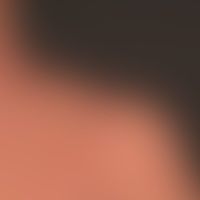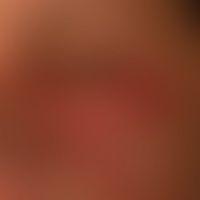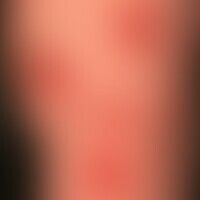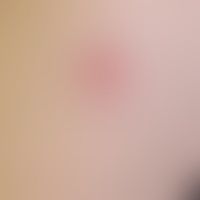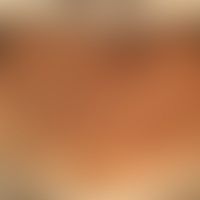Image diagnoses for "Plaque (raised surface > 1cm)", "red"
423 results with 1872 images
Results forPlaque (raised surface > 1cm)red

Lupus erythematosus tumidus L93.2
Lupus erythermatodes tumidus:chronic recurrent disease patternforseveral years. no itching, no other subjective complaints. significant improvement of symptoms under therapy with antimalarial drugs.
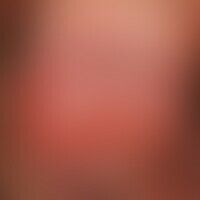
Erythroplasia queyrat D07.4

Atopic hand dermatitis L20.8
Hand eczema atopic: previously known atopic eczema with variable course; the skin lesions on both palms have existed with varying intensity for several years.

Contagious impetigo L01.0
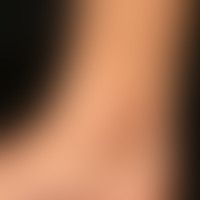
Hypertrophic Lichen planus L43.81
Lichen planus verrucosus: grouped, red, itchy, plaques that have existed for several months with a roughened, verrucous surface.
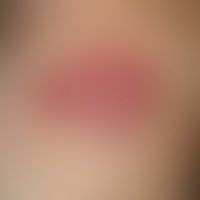
Primary cutaneous diffuse large cell b-cell lymphoma leg type C83.3
Primary cutaneous diffuse large-cell B-cell lymphoma leg type: Detail magnification: Approx. 4-5 cm diameter, irregularly shaped, bulging, deep red tumor with smooth surface of a 75-year-old patient.

Psoriasis palmaris et plantaris (plaque type) L40.3
Psoriasis palmaris et plantaris (plaque type): red and scaly, markedly indurated plaques on the palm of the hand. Sharp border to the flexor side of the forearm. This sharp transition to the unaffected skin differentiates palmar psoriasis from "hand eczema".
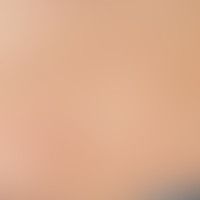
Erythema anulare centrifugum L53.1
Erythema anulare centrifugum: chronically active, centrifugally growing, ubiquitous (here localized on the trunk), red, smooth, solid, confluent anular plaques, the edges of which are palpable like a wet "wool thread".
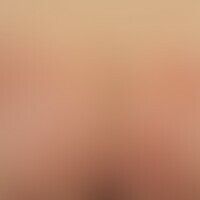
Parapsoriasis en plaques large L41.4
Parapsoriasis en plaques, large-hearth inflammatory form. general view: For the first time in the 39-year-old woman multiple, itchy, erythematous, brownish, partly scaly, partly confluent plaques appeared at the gluteal region during pregnancy. These spread to the legs in the course of the disease. transition from parapsoriasis en plaques to mycosis fungoides in the patch stage.
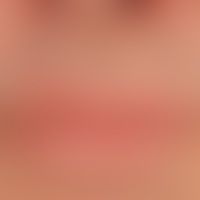
Psoriasis (Übersicht) L40.-
Psoriasis: psoriatic minus variant of the lips (psoriasis is detected by typical psoriatic plaques on the elbows and knees); discrete foci on the upper lip marked by arrows and a circle.

Granuloma fissuratum D23.L6
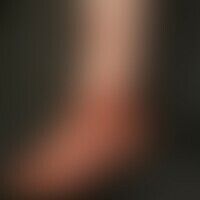
Hypertrophic Lichen planus L43.81
Lichen planus verrucosus with transition into a lichen palnus ulzerosus: verrucous and hyperkeratotic lichen planus of both feet and lower legs, existing for several years, and for several months flat deep ulcers without any healing tendency.

Contact dermatitis allergic L23.0
Contact dermatitis allergic: acute, itchy, relatively sharply defined, photoallergic (contact) dermatitis with pillow-like infiltrated, partly sharply defined, in the lateral cheek area also blurredly defined red plaques. multiple, partly solitary, partly confluent vesicles on cheeks, nose and forehead. 27-year-old female patient after application of a sunblock.
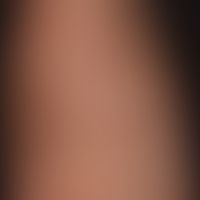
Parapsoriasis en plaques benign small foci L41.3
parapsoriasis en petites plaques. disseminated in the skin tension lines of the skin aligned, elongated, symptomless plaques (tiger pattern). significant improvement in the summer months.
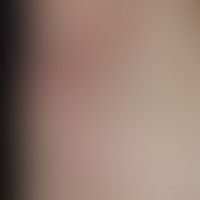
Lichen sclerosus (overview) L90.4
Lichen sclerosus of the axilla: large, less symptomatic, whitish, also reddish, atrophic shiny plaque; blurred, feathered border.
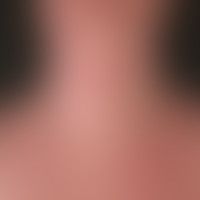
Atopic dermatitis (overview) L20.-
Eczema atopic (overview): severe atopic eczema existing for years, mainly flexural in adolescence, generalized for 2 years now. massive constant itching, intensified after sweating. numerous scratch marks.
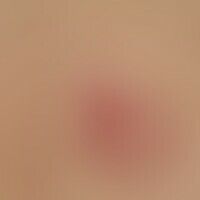
Basal cell carcinoma superficial C44.L
Basal cell carcinoma, superficial. for at least 4 years persistent, size constant, sharply defined, clearly border-emphasized plaque on the back of a 55-year-old patient. This is a partially regressive multicenter superficial basal cell carcinoma.

Psoriasis palmaris et plantaris (overview) L40.3
Psoriasis palmo-plantaris: Dry keratotic plaque type with sharp transition from healthy (forearm) to diseased "psoriatic" skin of the palm.

Primary cutaneous diffuse large cell b-cell lymphoma leg type C83.3
primary diffuse diffuse large cell B-cell lymphoma leg type: for about2 years papules and nodules on the left leg of a 55 years old woman appearing in relapses. in the last weeks rapid growth of the pre-existing nodules and eruptive appearance of new nodules. initially no symptoms. since 2 months increasing tendency to dry and also weeping surface scaling. in places complete decay of the nodules.
